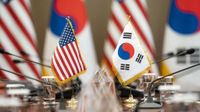On July 30, 2025, U.S. President Donald Trump announced a significant trade agreement with the Republic of Korea, marking a new chapter in the economic relationship between the two countries. The deal, which was publicized via Trump's social media platform Truth Social, sets tariffs for South Korean imports at 15%, while assuring that American goods will not face any tariffs in South Korea.
According to Trump’s announcement, the agreement includes South Korea providing the United States with $350 billion earmarked for investments owned and controlled by the U.S., selected under the president’s direction. This figure is a substantial commitment, underscoring the strategic economic cooperation envisioned between the two nations.
The tariffs set under the agreement apply specifically to automobiles and semiconductors imported from South Korea, both critical sectors in the global supply chain. However, steel and aluminum imports from South Korea will face a higher tariff rate of 50%, aligning with the global rates established by President Trump’s administration. This tiered tariff structure reflects a nuanced approach to balancing trade interests while protecting key American industries.
Further deepening the economic ties, South Korea has agreed to purchase $100 billion worth of energy resources from the United States. This aspect of the deal not only strengthens economic links but also addresses energy security and supply considerations amid a shifting global energy landscape.
Of the $350 billion pledged by South Korea, $150 billion is designated to assist the United States in shipbuilding efforts, including military vessels. This allocation highlights the defense and strategic dimensions embedded within the trade agreement, signaling a broadening of cooperation beyond mere commercial interests.
Adding a diplomatic layer to the agreement, President Trump announced that South Korean President Lee Jae-myung is scheduled to visit the White House in August 2025. This visit is expected to further solidify the partnership and allow for discussions on the implementation and future expansions of the agreement.
Since his inauguration in January 2025, Donald Trump has pursued an assertive trade policy, introducing numerous import tariffs on goods from various countries and threatening to impose more. He has justified these tariffs as measures to boost American manufacturing and safeguard jobs. However, his approach has been met with criticism and concern. Critics argue that such tariffs disrupt the global economy and result in higher prices for American consumers, complicating the balance between protectionism and free trade.
The South Korea trade deal exemplifies this complex dynamic. While it promises increased investment and stronger bilateral cooperation, the imposition of tariffs, particularly the steep 50% on steel and aluminum, raises questions about potential cost increases for industries relying on these materials, as well as for consumers.
President Trump’s announcement on Truth Social stated, "We agreed on a tariff for the Republic of Korea at 15%. There will be no tariff charged on America." This succinct message encapsulates the administration's intent to create a trade environment that favors U.S. interests while maintaining a degree of openness with a key ally.
The deal is a strategic move amid a broader context of fluctuating global trade policies and economic uncertainty. South Korea, a major player in technology and manufacturing, represents a vital partner for the United States, and this agreement seeks to recalibrate trade terms to benefit American economic and security priorities.
As the world watches how this agreement unfolds, the scheduled visit of President Lee to Washington will be a critical moment. It will provide an opportunity for both leaders to address any emerging challenges and to reinforce their commitment to a mutually beneficial partnership.
In sum, the new trade agreement between the United States and the Republic of Korea, announced by President Trump on July 30, 2025, sets a framework of tariffs and investments that reflect a blend of economic pragmatism and strategic alliance-building. While it promises significant financial flows and cooperation, the implications for industries and consumers will be closely scrutinized in the coming months.

